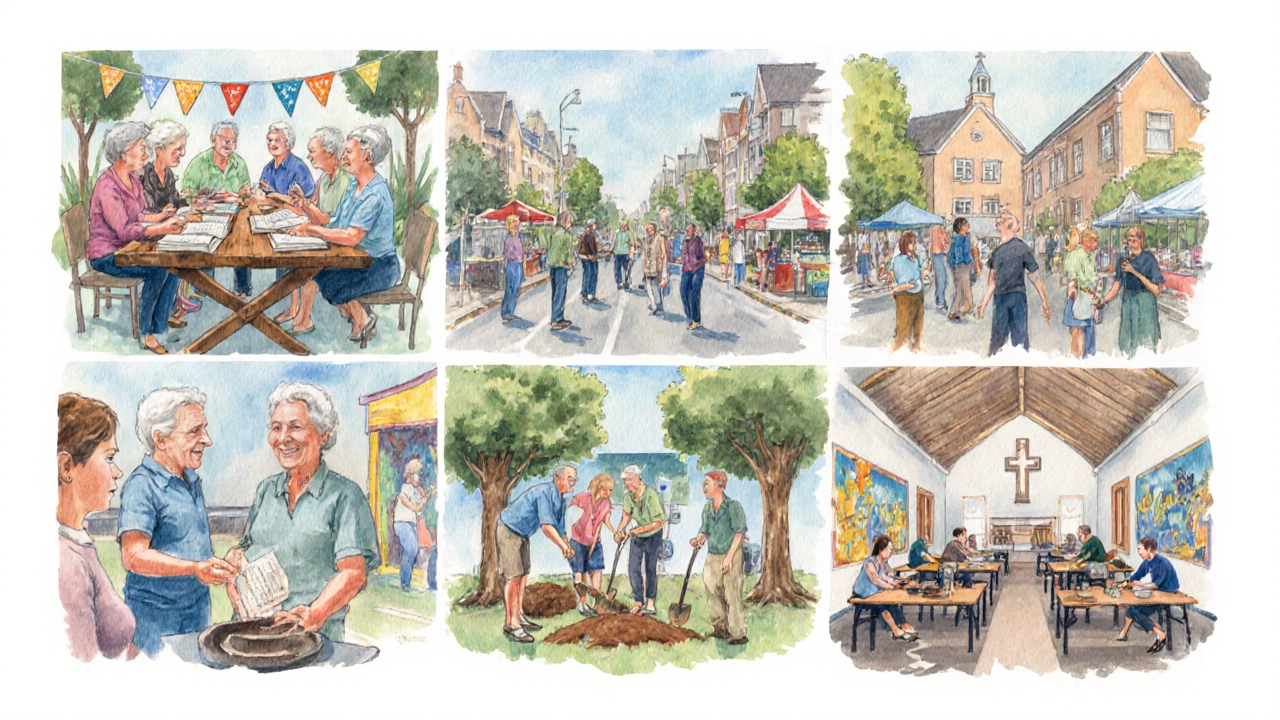Ever wonder why it feels harder to meet new people once you’re past your twenties? The truth is, adults still form strong friendships - they just happen in different places than they did in school. Below you’ll find a complete map of the most common spots where grown‑ups meet pals, plus simple steps to turn a brief hello into a lasting bond.
Why Adult Friendships Matter
Friendships in adulthood act like a personal health plan. Studies from the University of Chicago show that adults with at least two close friends have a 30% lower risk of early mortality. Beyond the health stats, friends provide emotional support during career changes, parenthood challenges, and the occasional mid‑life crisis. In short, a solid social circle isn’t a luxury - it’s a lifeline.
Top Places Adults Meet Friends
Below is a rundown of the venues that consistently top surveys from Pew Research (2023) and local community polls. Each setting comes with a brief snapshot of what makes it friend‑friendly.
| Venue | Typical Frequency | Age Range Most Common | Social Interaction Level |
|---|---|---|---|
| Workplace | Daily | 25‑55 | High |
| Community group | Weekly | 30‑65 | Medium‑High |
| Neighborhood events | Monthly | 20‑50 | Medium |
| Volunteering | Bi‑weekly | 25‑60 | High |
| Hobby class | Weekly | 18‑45 | Medium |
| Fitness club | 3‑5×week | 20‑55 | Medium‑High |
| Religious organization | Weekly | 30‑70 | High |
| Online forum | Daily | 18‑65 | Low‑Medium |
Workplace is a primary social environment where adults spend most of their waking hours, collaborating on projects and sharing break‑room jokes
The office (or remote‑work Slack channel) offers the highest interaction frequency. To spark a friendship, start with a shared task or a quick coffee break. Ask open‑ended questions like, “What’s the most interesting thing you’ve learned this week?” That simple cue often leads to deeper chats during lunch.
Community group is a local organization-such as a book club, gardening club, or neighborhood association-that meets regularly around a common interest
These groups attract people who already share a passion, cutting down the awkward “what do we talk about?” moment. Show up a few times, volunteer to help set up, and you’ll quickly be recognized as a reliable face. Consistency builds trust faster than one‑off encounters.
Neighborhood events are informal gatherings like block parties, street fairs, or local farmers’ markets that bring residents together in a relaxed setting
Because everyone lives nearby, there’s an easy fallback topic: “How long have you lived here?” Follow up with a suggestion to grab a coffee at the nearby café. A quick, low‑pressure meet‑up cements the initial casual chat.
Volunteering is a service‑oriented activity where adults donate time to charities, shelters, or environmental projects
People who volunteer usually have strong values, making it fertile ground for meaningful bonds. Pick a cause you care about, show up consistently, and you’ll naturally cross paths with like‑minded individuals. Share a quick story about why the cause matters to you; it often sparks heartfelt conversations.
Hobby class refers to structured learning sessions-like pottery, cooking, or dance-where adults practice a skill together
Skill‑based classes force collaboration: you’ll need a partner to help with a stitch or taste‑test a sauce. Use the activity as a conversation starter. After class, suggest meeting for a related outing, like visiting an art exhibit after a painting workshop.
Fitness club is a gym, yoga studio, or sports league that offers regular physical workouts and group classes
Group workouts create a built‑in camaraderie. Start with a simple remark about the trainer’s playlist or a shared struggle with a new pose. Many gyms host post‑class socials-great opportunities to extend the interaction beyond the mat.
Religious organization is a faith‑based community that gathers for worship, study groups, and service projects
Regular services and small‑group studies foster repeated contact. Offer to help with event set‑up or bring a snack to a study group; small gestures signal openness and build rapport.
Online forum means digital platforms-such as Reddit, Discord, or hobby‑specific message boards-where adults discuss shared interests
While virtual spaces lack physical proximity, they’re perfect for niche interests. Join a thread, contribute a thoughtful comment, and suggest a local meetup if the conversation clicks. Many offline clubs actually originated from these forums.
Turning a Casual Encounter into a Lasting Friendship
Spotting a potential friend is only half the battle. The next steps are all about consistency, authenticity, and a little bit of nudging.
- Exchange contact info quickly. Don’t wait for weeks; ask for a phone number or add them on a messaging app while the conversation is fresh.
- Schedule a low‑commitment hangout. Propose a 30‑minute coffee or a walk in the park. The goal is to move from group to one‑on‑one.
- Show genuine interest. Remember a detail they mentioned and bring it up later (“How did that presentation go last week?”).
- Share something about yourself. Vulnerability invites reciprocity; a short story about a hobby or a recent challenge builds trust.
- Follow up. A quick “Hey, I enjoyed our chat yesterday, want to try that new bakery?” keeps momentum.

Common Pitfalls and How to Dodge Them
Even with the best intentions, certain habits can sabotage budding friendships.
- Over‑scheduling. If you’re constantly proposing meet‑ups, the other person may feel pressured. Aim for a relaxed rhythm-once a week is a good baseline.
- Talking only about yourself. Balance is key. Mirror the 70/30 rule: listen 70% of the time, speak 30%.
- Assuming chemistry will happen instantly. Some connections need time. Give it a few interactions before deciding it isn’t a fit.
- Neglecting boundaries. Respect personal space and differing communication styles-some prefer texting, others meet in person.
Quick Checklist for Making Adult Friends
- Identify the venue that matches your interests (work, hobby, volunteering, etc.).
- Attend regularly - consistency beats one‑off visits.
- Start with a simple, open‑ended question.
- Exchange contact info within the first conversation.
- Plan a low‑pressure follow‑up activity.
- Show genuine curiosity and share a bit about yourself.
- Follow up within 48hours.
- Maintain the connection with periodic check‑ins.

Next Steps for Different Personas
If you’re a recent graduate moving to a new city, try a hobby class or a local meetup group. The shared learning environment speeds up bonding.
If you’re a busy professional, leverage your workplace and schedule a lunch‑hour coffee with a teammate you click with.
If you’re retired or semi‑retired, community groups, neighborhood events, and volunteering are low‑stress ways to meet peers with similar life stages.
If you’re introverted, start online-join a forum related to a hobby, then transition to a local meetup once you feel comfortable.
Frequently Asked Questions
How often should I meet new people to form a solid friendship?
Aim for at least one shared activity per week for the first month. Frequency helps establish routine and trust, after which bi‑weekly meet‑ups usually suffice.
Is it okay to ask a coworker to hang out outside of work?
Yes, as long as you keep the invitation low‑key. A coffee after work or a weekend brunch is a non‑intrusive way to test chemistry.
What if I’m shy about approaching strangers at a community event?
Start with a group activity-help set up a table, join a game, or assist the organizer. Collective tasks provide built‑in conversation starters and reduce pressure.
Can online friendships turn into real‑world friendships?
Absolutely. Many lasting friendships begin on niche forums. When you feel a rapport, suggest a casual meet‑up at a public place-coffee, a park, or a community class.
How do I maintain a friendship when both of us have busy schedules?
Use quick check‑ins-texts or voice notes-rather than long meet‑ups every time. Schedule regular catch‑ups quarterly, and fill the gaps with casual messages about shared interests.


